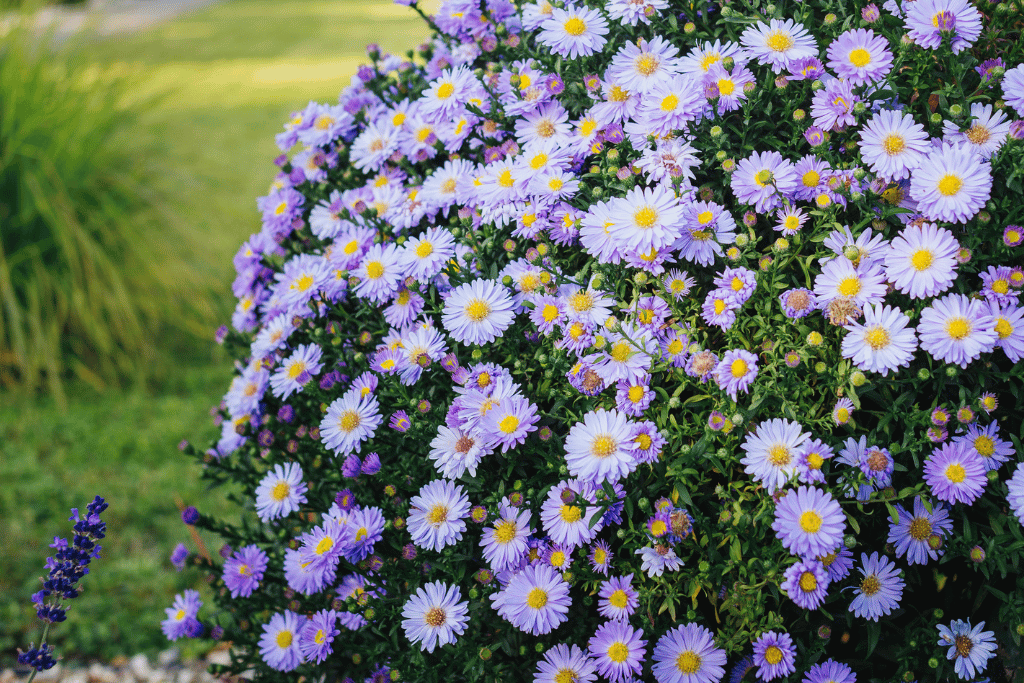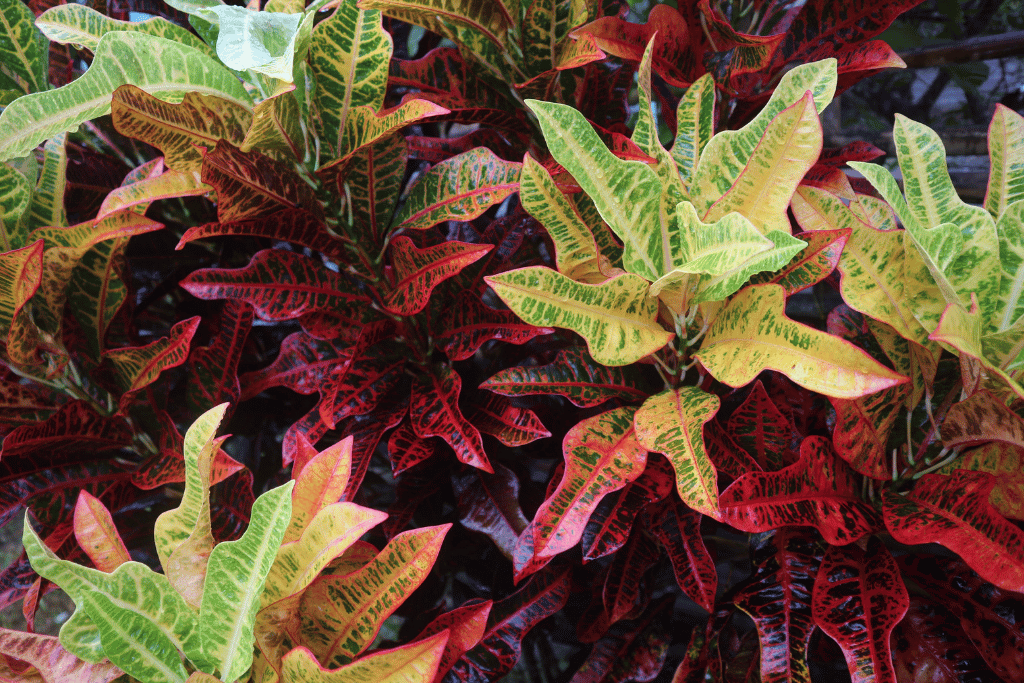Something about the Bird of Paradise plant’s exotic look prompts the thoughts of sitting in a hammock surrounded by lush greenery! However, the reality of maintaining such a plant can sound daunting to some. With its fussy humidity requirements and high demands, it can be a tricky plant even for the most advanced plant owners to care for.
Let’s take a look at how you can add some tropical flair to your garden with these bird-of-paradise doppelgangers.
What is Bird of Paradise?
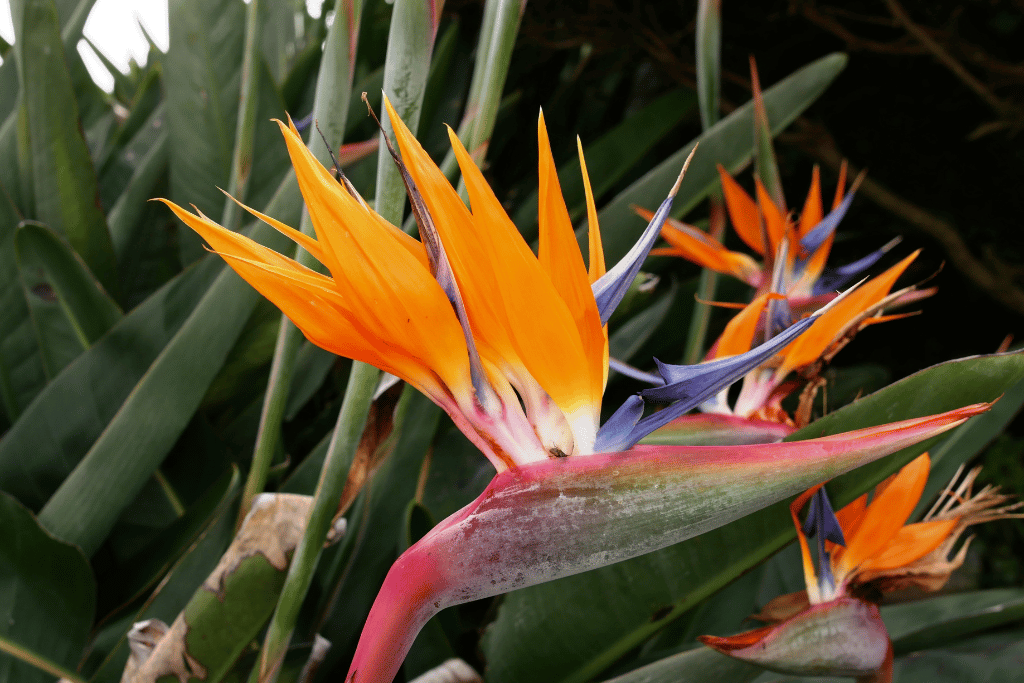
These iconic plants are beloved for their exotic appearance and dazzling blooms, which mimic the head of a colorful bird. Native to the south African rainforest, they have the ability to grow up to 6 feet tall and 3 feet (91cm) wide. The leaves of the bird of paradise are paddle-shaped with a glossy surface and thick leathery texture. They can grow up to 18 inches (45cm) long and 16 inches (40cm) wide, making them a prominent feature of the plant.
I have often seen these displayed in the foyer’s hotels or large entryways of offices. They make a great space filler, and if you have the height inside your home -why not!
The leaves of the Bird of Paradise are set out in a fan-like pattern, a common characteristic of plants adapted to tropical environments.
One exciting feature of the leaves is their ability to collect water, allowing the plant to survive in its dry surroundings. The channel-like structure in the center of the leaves collects the water and directs it down towards the base of the plant.
If you want to own a bird of paradise, the job doesn’t come easily. Birds of paradise require specific maintenance to keep them looking their best. For example, they require well-drained soil and consistent watering- but not too much, as they are vulnerable to root rot.
Fertilizer is also necessary, but too much can burn the roots. In addition, they benefit from careful pruning to encourage new growth and remove dead or diseased leaves.
| Common Name | Bird of Paradise, Crane Flower |
| Scientific Name | Strelitzia reginae |
| Origin | South Africa |
| Family | Strelitiziaceae |
| Type | Perennial |
| USDA Hardiness Zone | 9-11 |
| Temperature | Prefers 50-72F (10-22C) Can tolerate as low as 24F (-4C) |
| Humidity | 40-70% |
| Soil | Well-draining soil, pH 6-7.5 |
| Light | Full Sun to Part shade |
| Fertilizer | 10-10-10 NPK every two weeks during the growing season |
Is The Heliconia The Same as Bird of Paradise?
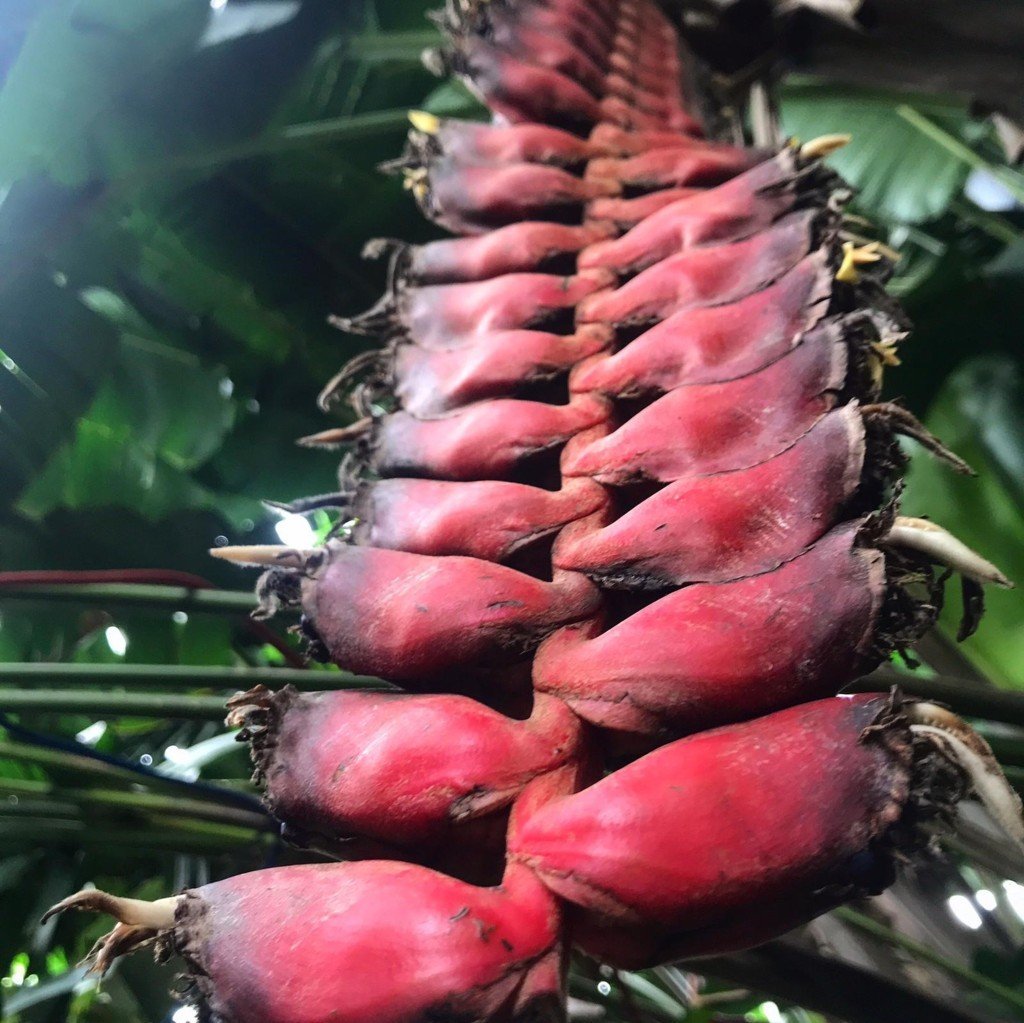
These stunning tropical plants are grown for their exotic-looking blooms that are shaped like bird beaks or lobster claws. Heliconia flowers consist of a long slender stem with a brightly colored bract or modified leaf surrounding the true flowers.
The bract can be red, yellow, orange, pink, or a combination of colors and can also be colored or striped. Luckily these blooms can last for several weeks, providing a beautiful display of color!
These plants that look like birds of paradise are perennial so that they can thrive for several years with proper care. They prefer warm, humid environments similar to their native habitat in Central and South America. While some plant enthusiasts grow Heliconias indoors in containers, they can take up quite a bit of space, so they are best suited for outdoor gardens or conservatories.
When it comes to looking after one of these tropical babies, you need to consider a couple of things.
Firstly, they need to be planted in well-draining soil, so they are not sat in water where they can be at risk of root rot.
Secondly, they need plenty of sunlight, so make sure to place them in a sunny spot.
Lastly, regular watering and fertilization are essential to keep their vigorous growth. Like the bird of paradise, the Heliconia does need a prune from time to time to remove the spent leaves and encourage new growth.
Keep an eye out for any signs of pests and diseases, and nip them in the bud if necessary.
| Common Name | Heliconia |
| Scientific Name | Heliconia spp. |
| Origin | Central and South America |
| Family | Heliconiaceae |
| Type | Perennial |
| USDA Hardiness Zone | 10-12 |
| Temperature | 60-80F (15-27C) |
| Humidity | 70-80% |
| Soil | pH 6.0-7.0 |
| Light | Bright Indirect Light |
| Fertilizer | 10-10-10 NPK |
Strelitzia Nicolai
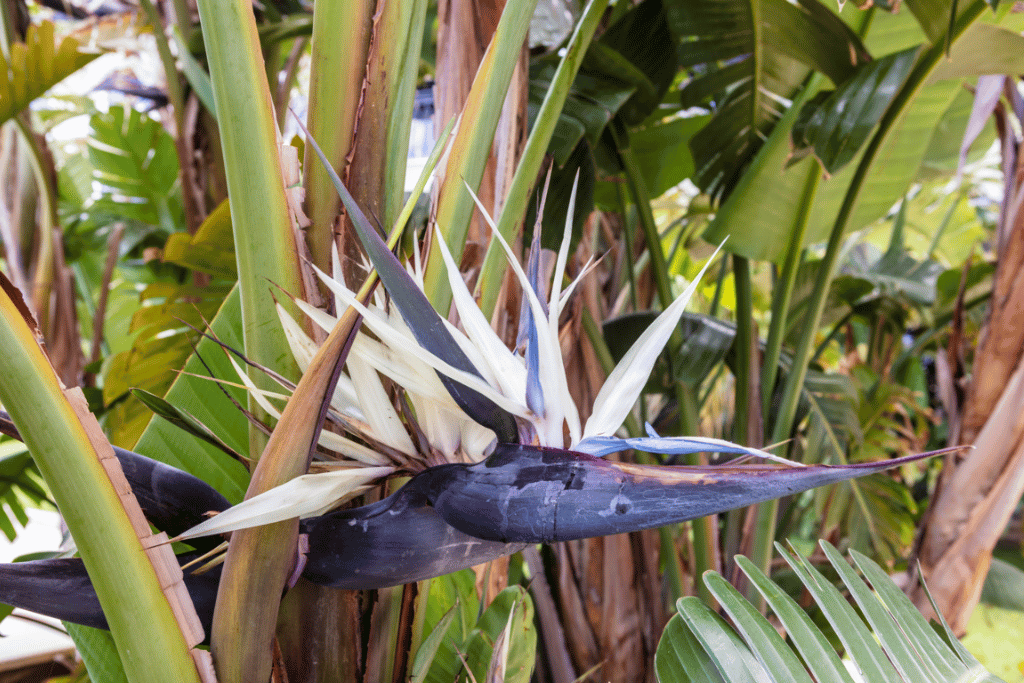
Also known as the Giant White Bird of Paradise this impressive jungle-like plant is native to South Africa and is the relative of the Strelizia regineae. One notable difference between the two of these species is the size. The Strelitzia nicolai can grow to a whopping 30 Feet (914cm) tall with paddle-shaped leaves measuring up to 10 feet (304cm) long. These features make the Giant White Bird of paradise a monster of a plant to own, so if you have space for one, then consider yourself lucky!
Another critical difference between these plants is the bird-shaped blooms. The Strelitzia nicolai produces white and blue flowers that are held on long stems, while the Strelitzia reginae displays its small orange and blue flowers on shorter stems.
When it comes to the care and maintenance of these plants, the Strelitzia nicolai benefits from regular watering, fertilizing, and pruning to thrive. You should plant it in well-draining soil in a location with bright indirect sunlight. As with its close relative, this plant that looks like the bird of paradise thrives in high humidity, so you may need to mist it occasionally to increase the humidity levels.
Proper care for the Strelitzia nicolai should include pest control. These plants are no exception when it comes to a place for spider mites and mealybugs to live. If you notice any issues, it’s essential to put a stop to them before they destroy your beloved plant.
When pruning the Giant White bird of paradise, make sure you use a clean, sharp pair of secateurs and cut the damaged or diseased leaves at an angle. This regular prune will keep it looking tip-top, and it will continue to grow new fresh leaves.
| Common Name | Giant White Bird of Paradise |
| Scientific Name | Strelitzia nicolai |
| Origin | South Africa |
| Family | Streliziaceae |
| Type | Evergreen perennial plant |
| USDA Hardiness Zone | 9-11 |
| Temperature | 50-75F (10-23C) |
| Humidity | 50-70% |
| Soil | 6.0-7.5 |
| Light | Bright Indirect Sunlight |
| Fertilizer | 10-10-10 NPK |
Canna Lilly
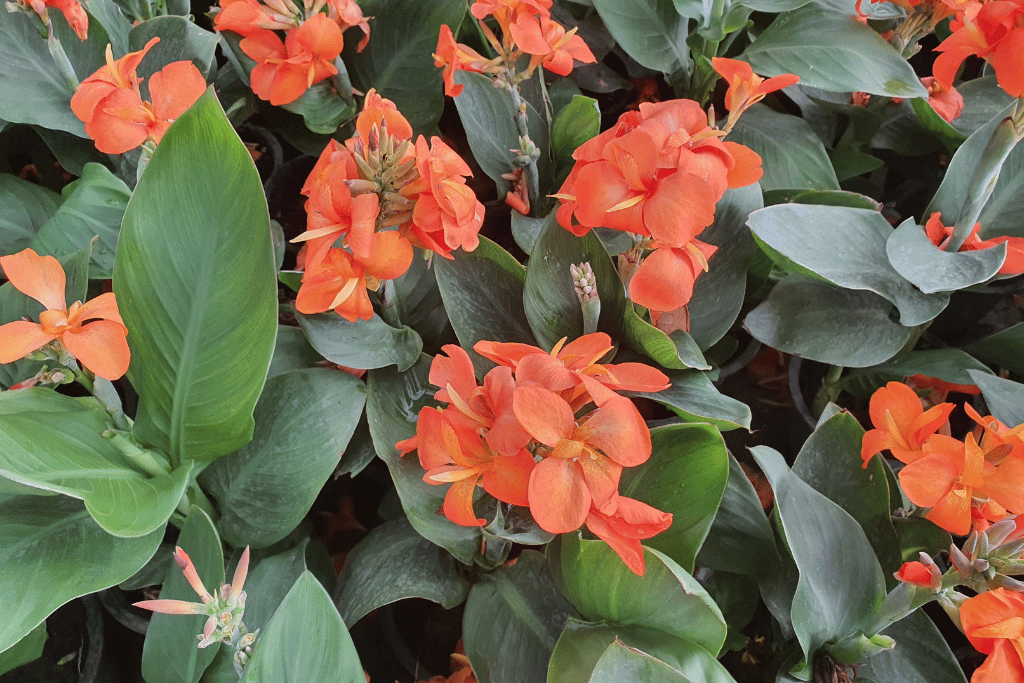
Canna Lillies are a gorgeous and versatile addition to any garden or landscape. They are herbaceous plants that can grow up to 6 feet tall (182cm) with large paddle-shaped leaves in bright shades of red, orange, and yellow or pink. They are widely recognized for their vibrant showy blooms that can last for several weeks.
To keep your Canna lilies looking their best, you will need to provide they do require a little maintenance. Regular watering and fertilizing them with a balanced fertilizer every few weeks will ensure they keep their head-turning appearance.
This plant that looks like the bird of paradise needs a light prune from time to time to remove its old leaves and spent flowers. Be mindful of any pests that come their way too- the canna lilies can be susceptible to fungus gnats and spider mites, which all love the humid conditions this plant demands.
When it comes to planting Canna lilies, ensure you are using well-draining soil that is rich in organic matter and keep them in a sunny location where they can receive full sun for 6 hours a day.
During the hot or dry months, you may need to water them more frequently to prevent them from drying out, and another option is to add a layer of mulch to the base of the plant to regulate soil temperature and help with water retention.
All in all, Canna lilies are a beautiful plant, with so many colors to choose from- the ones with the stripey leaves are a favorite of mine!
| Common Name | Canna Lily |
| Scientific Name | Canna indica |
| Origin | Tropical and Subtropical regions of the Americas |
| Family | Cannaceae |
| Type | Herbaceous Perennial |
| USDA Hardiness Zone | 7-11 |
| Temperature | 60-80F (15-26C) |
| Humidity | 50-70% |
| Soil | 6.0-7.5 |
| Light | Full Sun |
| Fertilizer | 10-10-10 NPK |
Ginger Lilly
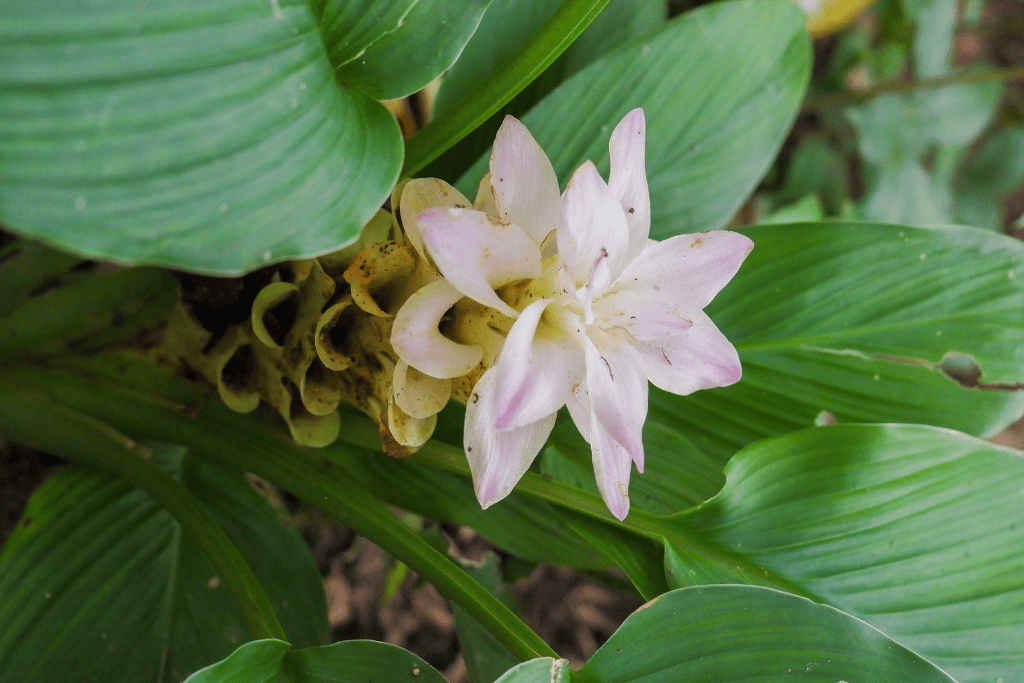
Ginger lilies are as stunning as they are fragrant. These plants emit a spicy sweet scent that is often compared to that of ginger. This fragrance is particularly noticeable in the evening, making ginger Lilies an excellent choice for a nighttime garden.
These plants that look like the Bird of paradise are also known as Hedychium, which are a group of tropical plants known for their showy appearance and spicy fragrance. They are native to Asia and can grow up to 6 feet tall (182cm).
The flowers of the ginger lilies come in a range of colors, from white to pink to orange. The blooms are often used in floral arrangements because they are so pretty and last a long time. The shape of the flowers is quite a bit different from the Bird of paradise, but the Ginger lilies have the same paddle-shaped leaves found among popular tropical plants.
Speaking of appearance, the ginger lilies are tall, slender plants, and the blooms themselves are often trumpet-shaped and have a slightly ruffled edge giving them a whimsical, playful appearance. The plants are relatively easy to look after, but they thrive in areas with heavy rainfall.
If you live in a dry area, you must supplement this with a regular watering regimen. These spicy babies love well-draining soil and shady spots where they can gain bright indirect light for 6 hours daily. When it comes to pruning, they like a little trim to remove the dead leaves and keep their energy focused on new growth.
Overall if you want to add some personality to the garden, ginger lilies are a great choice. These plants have an exotic quality, making them stand out from the crowd.
| Common Name | Ginger lilies |
| Scientific Name | Hedychium |
| Origin | South East Asia and Himalayas |
| Family | Zingiberaceae |
| Type | Perennial Herbaceous Plant |
| USDA Hardiness Zone | 7-11 |
| Temperature | 60-80F (15-27C) |
| Humidity | 70% |
| Soil | pH 5.5-7.0 |
| Light | Bright Indirect Sunlight |
| Fertilizer | 10-10-10 NPK |
Banana Plant
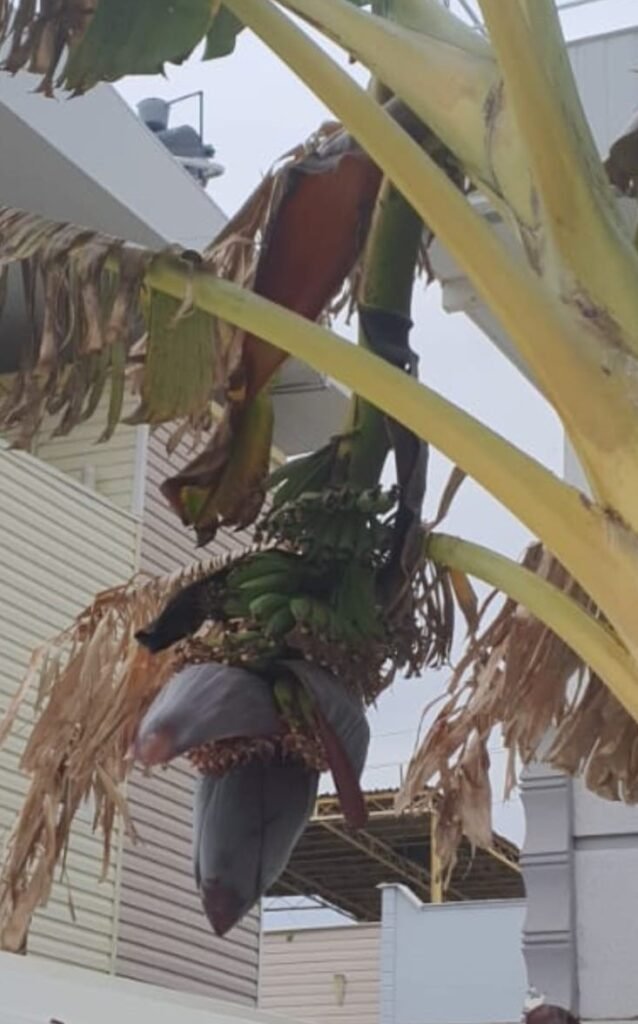
Banana plants are a real hottie for sprucing up your garden. They scream a tropical vibe and produce amazing fruits to share with your family and friends. These plants are easy to care for, but you must watch out, as they can take over your garden in no time!
One of the cool things about these plants that look like Bird of Paradise is that they grow really fast. They can shoot up like a rocket and reach their full potential in a matter of months. And once they start growing, they just keep chugging along!
Don’t worry though; you don’t need to be an expert gardener to keep them under control. Just make sure you cut back their dead leaves and prune the stems regularly to keep them in check.
Banana plants also love to soak up the sun, so make sure to plant them in a spot where they can bask in the sunshine all day. They also need plenty of water to keep them hydrated, so don’t forget to give them a good soak from time to time.
Banana plants are a type of herbaceous plant that can grow up to 30 feet (914cm) tall. They have a similar paddle-shaped leaf similar to the bird of paradise and, when not in bloom, can often be mistaken for the same plant. The long stems bloom exotic edible flowers, and clusters of small sweet fruit appear after flowering. If you decide to add banana plants to your garden, try to keep them in a place that isn’t battered by heavy winds as the leaves spilt and tear with the pressure. This doesn’t kill the plant but makes them lose its lush look.
| Common Name | Banana plants |
| Scientific Name | Musa spp. |
| Origin | South East Asia |
| Family | Musaceae |
| Type | Herbaceous Perennial |
| USDA Hardiness Zone | 9-11 |
| Temperature | 75-95F (24-35C) |
| Humidity | 50-80% |
| Soil | pH 5.5-6.5 |
| Light | Full Sun to Part Shade |
| Fertilizer | 10-10-10 NPK |
Caesalpinia
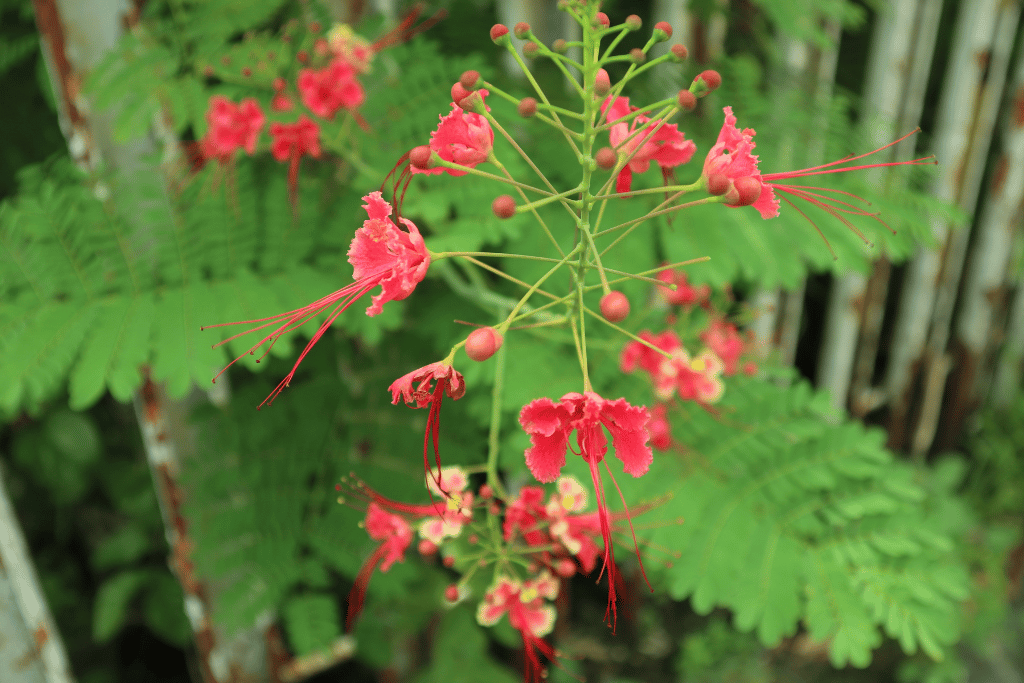
This skyscraper of a plant knows how to make a real statement! It blooms vibrant flowers and unique pinnate foliage that will turn heads and catch people’s attention. Don’t let its flashy appearance fool you, though- this plant is as tough as nails! It can tolerate drought conditions and salt spray, making it a popular choice for coastal gardens.
One of the most incredible things about Caesalpinia is its ability to attract pollinators such as honeybee butterflies and hummingbirds, which is excellent for supporting the local wildlife. Caesalpinia also likes to spread its wings and grow to heights of 20 feet and upwards if left unchecked. But don’t worry if you don’t have that kind of space in your garden; you can prune it back regularly and train it to grow in the shape you want.
If you’re going to keep your Caesalpinia happy and healthy, give it plenty of sunshine and well-draining soil. It’s like a sunbather that loves to soak up the rays! And if you give it a little extra care in the form of fertilizer, it will reward you with more impressive flowers.
The foliage of this plant is not like the Bird of Paradise as they have pinnate leaves, which means they are made up of leaflets arranged in a feather-like pattern along a central axis. The leaflets can be oval or lance-shaped and are up to 4 inches long. These leaves are bright green and provide a nice contrast to the plant’s colorful flowers.
| Common Name | Caesalpinia |
| Scientific Name | Caesalpinia spp |
| Origin | Tropical and Subtropical Regions of the Americas, Asia and Africa |
| Family | Fabaceae (Pea Family) |
| Type | Evergreen or Deciduous Shrubs or Small trees |
| USDA Hardiness Zone | 9-11 |
| Temperature | 65-85F (18-29C) |
| Humidity | 50-80% |
| Soil | pH 5.5 to 7.5 |
| Light | Full Sun to Part Shade |
| Fertilizer | 10-10-10 NPK Every 2 -3 Weeks |
Plants that Look Like Bird of Paradise Explored
After looking at all the different plants that look like Bird of paradise you can see why they are mistaken. Their similar appearance is notable within their tropical leaves and showy blooms. While these plants share these similarities, they each have their own unique characteristics and growing requirements.
If you do decide to show off your green thumb, you will receive endless admiration from jealous neighbors and bouts of uncontrollable happiness every time it blooms. Happy growing!
FAQ About Plants that look like Bird of Paradise
Is Heliconia the same as bird of paradise?
No, they are different plants. The heliconia is sometimes named the false bird of paradise. They have similar characteristics but are totally different species.
What is the plant that looks like a bird?
Strelitzia reginea is the Bird of paradise, displaying orange and blue blooms resembling the crane bird.
What are the plants that look like a duck?
The Flying Duck Orchid is a plant that blooms delicate petals structured like a duck in flight. It is scientifically known as Caleana major and is native to Australia.


